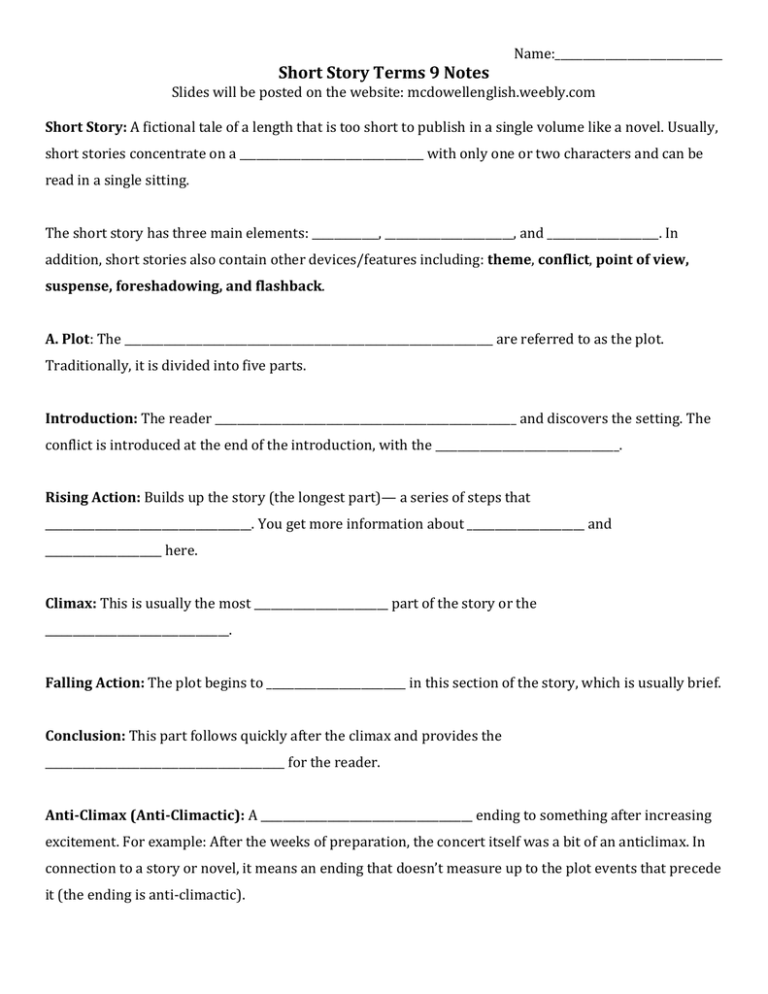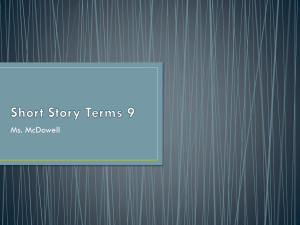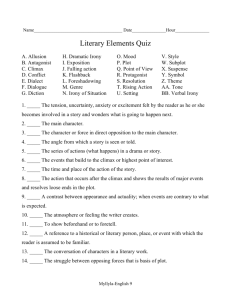Short Story Terms 9 Notes
advertisement

Short Story Terms 9 Notes Name:______________________________ Slides will be posted on the website: mcdowellenglish.weebly.com Short Story: A fictional tale of a length that is too short to publish in a single volume like a novel. Usually, short stories concentrate on a _________________________________ with only one or two characters and can be read in a single sitting. The short story has three main elements: ____________, _______________________, and ____________________. In addition, short stories also contain other devices/features including: theme, conflict, point of view, suspense, foreshadowing, and flashback. A. Plot: The __________________________________________________________________ are referred to as the plot. Traditionally, it is divided into five parts. Introduction: The reader ______________________________________________________ and discovers the setting. The conflict is introduced at the end of the introduction, with the _________________________________. Rising Action: Builds up the story (the longest part)— a series of steps that _____________________________________. You get more information about _____________________ and _____________________ here. Climax: This is usually the most ________________________ part of the story or the _________________________________. Falling Action: The plot begins to _________________________ in this section of the story, which is usually brief. Conclusion: This part follows quickly after the climax and provides the ___________________________________________ for the reader. Anti-Climax (Anti-Climactic): A ______________________________________ ending to something after increasing excitement. For example: After the weeks of preparation, the concert itself was a bit of an anticlimax. In connection to a story or novel, it means an ending that doesn’t measure up to the plot events that precede it (the ending is anti-climactic). Plot Diagram: Also known as _________________________________, the story diagram or plot diagram is a way to visually represent the five plot parts. Modern stories may or may not tidily fit Freytag’s Pyramid. Protagonist: The _________________________________ in the story. The protagonist is usually, but not always, a “good guy.” Antagonist: The _________________________________ the protagonist. The antagonist is usually another character, but not always. The antagonist is usually described as “the bad guy”, although this is not always the case. Dynamic: A dynamic character ______________________ in some important way because of plot events. For example: a cruel old man might see the error of his ways and become generous and kind, or a gentle girl becomes vicious and angry because her parents divorce. Static: These characters are the opposite of dynamic characters. They ______________________________ through the course of a story. They have the same personality throughout. Methods of Characterization (ways we learn about characters) 1. _______________________ Characterization: The author directly tells you about the characteristics. “Dottie was the talker, the outgoing one – the extrovert. Jack was too shy around girls to say much at all.” 2. ________________________ Characterization: Revealing a character’s personality through: the character’s thoughts, words, and actions; the comments of other characters; or the character’s physical appearance. C. Setting: Emotional Setting Physical Setting Theme: The __________________________ of the story, stated in one or two complete sentences. When a person describes a story’s theme, the person is describing what can be learned about life and/or people from the story. Try not to confuse theme with ‘the topic’, which is the subject a piece of writing is about. For example, the topic of Scooby Doo is solving mysteries, yet one theme of Scooby Doo is that good triumphs over evil. Conflict: Conflict drives the plot forward and is either described as internal or external: Internal Conflict: When the conflict is an internal struggle within a character. Usually characters, like real people, have conflicting fears and goals that cause them to behave in certain ways. Person vs. ______________________ External Conflict: When the conflict is outside a character in a short story/ novel. External conflict is best described as the adversities faced by the character during the plot. Person vs. ______________________ Person vs. ______________________ Person vs. ______________________ Person vs. ______________________ Point of View: Who is ___________________________ and how is he/she telling it: _____________ Person: “I” is the central character and tells his or her own story. _____________ Person ______________________: Characters are referred to as “he” and “she”, and the reader knows all characters’ thoughts/feelings _________________________________: Characters are referred to as “he” and “she”, and the reader knows one character’s thoughts/feelings ______________________: The story is about “he” or “she”, and the author records action objectively, as a movie camera would. The reader does not see any of the character’s thoughts (doesn’t get inside their heads). Flashback: When a character thinks back to/describes an event that occurred ______________________ the story began. Foreshadowing: A ___________________________________________ in the story. Suspense: Anxiety or apprehension resulting from an uncertain, undecided, or mysterious situation. Suspense is when the writer creates ______________________ of an approaching climax in the reader. Dilemma: A dilemma is a ___________________________________ where neither of the two choices is ideal. Irony – opposite of what is expected/meant. ______________________ Irony – a situation that is the opposite of what one might expect. Eg. A driving instructor causes a car accident. ______________________ Irony – when someone says something but they opposite is true/they mean the opposite. Eg. Commenting on the “lovely weather we’re having” when it’s pouring rain. ______________________ Irony – when the reader/audience knows something that a character does not. Eg. End of “The Veldt” – we know that the children locked the parents in the nursery, but David McClean does not know this when he arrives. Symbol: something that ______________________, or stands for something else. Eg. A rose symbolizes love; a lion symbolizes courage. Terms quiz Beginning of Thursday’s class /20 Fill-in-the-blanks, definitions/examples Review game in-class on Tuesday – come prepared!




